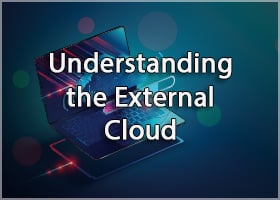The revolutionary aspect of cloud technology is that it separates hardware from software. This separation has spawned a multitude of new business capabilities and opportunities.
Without the constraints of hardware, businesses can use the cloud — either internally or externally — to increase agility, performance, efficiency, scalability, and intelligence. The potential applications of cloud-based infrastructure are endless, because everything can be customized to a near-granular level.
Cloud infrastructure removes hardware constraints, so business needs and goals are the only consideration. In other words, once you can define what your business needs are, you can create the right cloud solution.
There are good reasons to choose both internal and external cloud solutions. Each one fits a different set of business requirements. This article will take a look at the pros and cons of both, along with some example use cases, to help you identify which kind of cloud might best suit your organization.
Understanding the Internal Cloud
 An internal cloud uses the same kind of software infrastructure as the public cloud, but the physical infrastructure is located on-premises. There are a few reasons why an organization would keep its infrastructure on-site.
An internal cloud uses the same kind of software infrastructure as the public cloud, but the physical infrastructure is located on-premises. There are a few reasons why an organization would keep its infrastructure on-site.
For instance, if a company has already invested in physical infrastructure and needs to achieve the highest possible return, the infrastructure can be repurposed to serve as a private cloud while it serves out its lifecycle. Depending on considerations such as performance and requirements, older on-premises infrastructure can be used as a cloud backup while business applications move to newer external cloud infrastructure.
Internal Cloud Pros
The other two reasons many organizations keep some, or all, of their infrastructure on-premises are:
- Security: Businesses with high security requirements, like banks or healthcare organizations, may keep their most sensitive data and applications on-premises.
- Performance: Companies that rely on high-performance applications, such as analyst firms or high-tech companies, may need the low latency and high performance of an on-site solution.
Internal Cloud Cons
While internal cloud offers complete infrastructure control plus high levels of performance and security, there are drawbacks:
- High cost: Hardware infrastructure has to be purchased outright, as a capital expenditure. Plus, there is the ongoing cost of staff support, electricity, and physical space.
- Increased responsibility: When you host your own infrastructure on-site, you are fully responsible for all aspects of it, including security, maintenance, and issue resolution.
Understanding the External Cloud
 The term external cloud refers to infrastructure that resides outside an organization’s physical location. Well-known examples of external cloud include Microsoft Azure and AWS. But there are many other options available in the realm of external cloud offerings.
The term external cloud refers to infrastructure that resides outside an organization’s physical location. Well-known examples of external cloud include Microsoft Azure and AWS. But there are many other options available in the realm of external cloud offerings.
Pros
The pros of external cloud are attractive enough that most businesses use some form of cloud infrastructure. The benefits of external cloud include:
- Adaptability, scalability, and agility.
- Cost-effective OpEx-friendly payment structure. Buying external cloud services is like buying utilities.
- Provides accessibility to cutting-edge technology that includes security features, development environments, and machine learning.
- Can offer a degree of removal from responsibility, compliance, security, maintenance, and issue resolution. (This depends on the provider and level of service offered.)
Cons
While the external cloud offers great benefits, affordability, scalability, and cutting-edge technology, there are also potential disadvantages:
- Possible loss of control. Depending on the cloud service you choose, you could lose some control over the environment. For example, some cloud providers don’t offer high uptime guarantees and might take your cloud server down for maintenance during your business hours.
- Cloud providers offer widely varying degrees of support, from a close business partnership to complete user responsibility (100% at your own risk).
- May need to share resources. While shared resources are fine in some use cases, security concerns or provider trust level could be an issue in others.
- Latency or lag-time issues. These will depend on the environment and how it is being used.
Although external cloud infrastructure can have its drawbacks, it is possible to mitigate most or all of them. The key is choosing the right partner or cloud provider to fit your needs. Service levels vary widely, from do-it-yourself solutions to full-service business partnerships.
Hybrid Cloud: A Nod to a Third Option
More companies choose the best-of-both-worlds approach, also known as hybrid cloud. With a hybrid cloud solution, a part of the infrastructure remains on-premises, while the rest moves to the external cloud. For instance, older infrastructure could be reformatted and used as backup or on-site storage while newer applications and workloads move to cloud infrastructure.
In another scenario, high-performance or high-security applications remain on-premises, and off-site cloud environments are used for backup and recovery or data analysis purposes. As with all other cloud options, the business use case is the main factor to influence the solution design.
While this article offers a high-level look at internal and external cloud options, the best way to determine which cloud solution is best for your business use case is a cloud assessment.
A hands-on cloud service provider can help with all aspects of cloud transition: assessment, design, implementation, and management. Let us help you plan a cloud transition that helps you reach your business goals.
Learn more about our cloud services and solutions.




Comment Form